Review
On Halloween, we focused on the prophesy of the Seed—the coming Conqueror, who would defeat our adversary, the devil (Gen. 3:14-15). This coming Savior was to be a male child (seed), born of a woman. He would conquer (crush the head of) the devil (the Serpent) who tempted the first couple. If you haven’t yet read part 1 of this series, I suggest doing so before continuing.
The Arrival of Christ
Today, however, we are way beyond the dim lights of prophecy. The promised Seed has arrived! This amazing prophecy we celebrated at Halloween (Gen. 3:14-15) has been fulfilled in the histories we celebrate at Christmas and Easter.
Christmas
Christmas is the is the second holiday of my year-long Gospel presentation.
- The Fall and the Promise of Christ – Halloween
- The Arrival of Christ – Christmas
- The Cross of Christ
- The Return of Christ
If you want to know what Christmas is all about, look no further than Linus van Pelt—the wisest animated character of all time. In response to a frustrated Charlie Brown, he proclaimed:
And there were in the same country shepherds abiding in the field, keeping watch over their flock by night, and, lo, the angel of the Lord came upon them, and the glory of the Lord shone round about them: and they were sore afraid, and the angel said unto them, Fear not: for, behold, I bring you good tidings of great joy, which shall be to all people. For unto you is born this day in the city of David a Saviour, which is Christ the Lord. And this shall be a sign unto you; Ye shall find the babe wrapped in swaddling clothes, lying in a manger. And suddenly there was with the angel a multitude of the heavenly host praising God, and saying, Glory to God in the highest, and on earth peace, good will toward men.
.
That’s what Christmas is all about, Charlie Brown.
The wait is over. The long awaited Seed, Messiah, Savior has arrived.
Missing Christmas
That said, Christmas is lost on many, including many Christians. Its symbols and themes are familiar and nice, but not particularly meaningful. For many they are confusing, even distracting. Where is Jesus in all this?!
I thought the same way for many years as a new Christian. Christmas was always fun, especially celebrating with my kids, but no big deal. Its symbols had little meaning to me. That all changed, however, after a little digging and research. If you are where I was, I recommend taking a closer look at some of these symbols and traditions. You may be missing a blessing in plain sight.
Using Christmas Symbols
I find a treasure trove of opportunity in Christmas symbols. Most are packed with traditional theological meaning which merely needs to be learned and shared. Others, admittedly, lack traditional meaning, but are full of potential, as I’ll explain. Bottom line, Jesus is everywhere during Christmas season.
Christmas Lights
 Christmas is the light-show of the year. In a real sense, Christmas is all about the lights. That said, most are in the dark about their significance and meaning. Don’t let your kids be among these.
Christmas is the light-show of the year. In a real sense, Christmas is all about the lights. That said, most are in the dark about their significance and meaning. Don’t let your kids be among these.
Theological Significance of Lights
During Halloween, we saw significance in the dim lights which represented the prophecy of the coming Seed (Gen. 3:14-15). Christmas, by contrast, is about bright lights. They represent the historical arrival of the Seed—Jesus—the light of the world.
John 8:12 Then Jesus spoke to them again, saying, “I am the light of the world. He who follows Me shall not walk in darkness, but have the light of life.”
Jesus is the bright light who shines in the darkness.
John 1:4 In him was life, and that life was the light of all mankind. 5 The light shines in the darkness, and the darkness has not overcome it. ……9 The true light that gives light to everyone was coming into the world.
Angels as Lights
These lights also symbolize the brilliant Angels who announced Christ’s birth to the shepherds (Luke 2:8-20). No modern light-show could possibly rival this one. As the classic song goes,
Said the night wind to the little lamb:
“Do you see what I see?
Way up in the sky, little lamb
Do you see what I see?
A star, a star, dancing in the night
With a tail as big as a kite
With a tail as big as a kite”
Lights also represent the followers of Jesus, who become children of light.
John 12:35 Then Jesus told them, “You are going to have the light just a little while longer. Walk while you have the light, before darkness overtakes you. …. 36 Believe in the light while you have the light, so that you may become children of light.”…
Those of us who believe are commanded to shine brightly in a dark world.
Matt. 5:14 “You are the light of the world. A town built on a hill cannot be hidden. 15 Neither do people light a lamp and put it under a bowl. Instead they put it on its stand, and it gives light to everyone in the house. 16 In the same way, let your light shine before others, that they may see your good deeds and glorify your Father in heaven.
History of Christmas Lights
Some believe this tradition can be traced back to the reformer Martin Luther (See: ‘The First Christmas Tree Lights’). The tradition using modern electric bulbs, on the other hand, is generally traced to Edward Johnson, a friend and business partner of Thomas Edison (See: Here’s How Christmas Lights Came to Be).
Regardless, everyone loves Christmas lights. Don’t miss the opportunity they provide. Remind your kids of their meaning every year. Do it until they start reminding you!
Winter Solstice
No one knows the exact calendar date Jesus was born. Virtually all Christians understand it was NOT on December 25th. This is merely the day we set aside to celebrate it. That said, I’m thankful for this date as it provides some great usable symbolism.
The Darkest Season
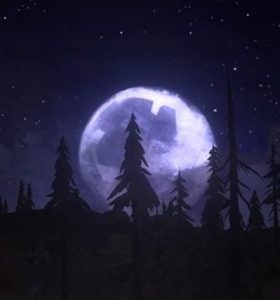 Christmas comes to us in the dead of winter, which is the darkest time of year. The Winter solstice occurs around December 21st, when we have the longest night, and shortest day of the year. Christmas Eve is just three days later. What a fitting time to celebrate the arrival of Jesus into a spiritually dark world. He is the light who shines in the darkness (John 1:5).
Christmas comes to us in the dead of winter, which is the darkest time of year. The Winter solstice occurs around December 21st, when we have the longest night, and shortest day of the year. Christmas Eve is just three days later. What a fitting time to celebrate the arrival of Jesus into a spiritually dark world. He is the light who shines in the darkness (John 1:5).
During Halloween, we used the Fall Equinox (when the nights first overtook the days) to explain the origin of spiritual darkness. Likewise, use the Winter Solstice to explain the depth that darkness had reached, when Christ arrived.
John 1:5 And the light shines in the darkness, and the darkness did not comprehend it.
The Coldest Season
Winter is also the coldest season of the year, which can represent the coldness of human nature and the cold reception Christ received when he entered the world.
John 1:10 He was in the world, and though the world was made through him, the world did not recognize him. 11 He came to that which was his own, but his own did not receive him.
Use this valuable symbol to teach your kids important theological concepts like human depravity, the sin nature, and our desperate need for a Savior.
Christmas Colors
Christmas colors are the first things that comes to my mind when thinking about Christmas symbolism. Red and green dominate, with splashes of gold and backgrounds of white. These colors are prominently displayed in lights and decorations, everywhere.
Red & Green
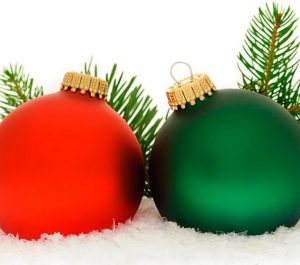 Red and green are the foundational colors of Christmas—red, representing the blood of Christ, and green representing the life that blood bought.
Red and green are the foundational colors of Christmas—red, representing the blood of Christ, and green representing the life that blood bought.
Jesus dying for our transgressions was clearly prophesied hundreds of years before he was born (Is. 53). The Magi, who visited Christ as a child, offered him myrrh, which was an embalming oil. From the very beginning, Jesus was the “….Lamb slain from the foundation of the world….” (Rev. 13:8).
It is through this death, that we have everlasting eternal life.
John 11:25 Jesus said to her, “I am the resurrection and the life. He who believes in Me, though he may die, he shall live. 26 And whoever lives and believes in Me shall never die. Do you believe this?”
This life is symbolized by the color green, which is the color of vegetation. Educate your kids about these colors every Christmas season.
GOLD
 Gold reminds us of the riches we have in Christ—those of us who believe. Let gold remind you of the streets of gold we’ll inherit.
Gold reminds us of the riches we have in Christ—those of us who believe. Let gold remind you of the streets of gold we’ll inherit.
Rev. 21:21 …. The great street of the city was of gold, as pure as transparent glass.
Think, also, of the gift of gold the Magi gave to Jesus. (Gold Frankincense & Myrrh). Gold was a gift for kings, symbolizing Christ, our king.
Is. 9:6 For unto us a Child is born, Unto us a Son is given; And the government will be upon His shoulder.
SNOW
 Snow is a prominent symbol during Christmas season—even where it doesn’t snow. It’s pure white color reminds us of the cleansing of our sin and positional purity we have in Christ. As the classic hymn says,
Snow is a prominent symbol during Christmas season—even where it doesn’t snow. It’s pure white color reminds us of the cleansing of our sin and positional purity we have in Christ. As the classic hymn says,
White as snow
white as snow, though my sins were as scarlet
Lord I know, Lord
I know, That I’m clean and forgiven
Through the power of your blood, through the wonder of your love, through faith in you I know that I can be
white as snow
The coldness of snow, like the coldness of Winter, can also remind us of our cold dead nature. Christ came that we might be saved from this fallen state and purified unto eternal life.
Don’t allow the symbolism of snow to go unnoticed. Use it to explain the washing of regeneration.
Titus 3:5 not by works of righteousness which we have done, but according to His mercy He saved us, through the washing of regeneration and renewing of the Holy Spirit, 6 whom He poured out on us abundantly through Jesus Christ our Savior,
SNOWMEN
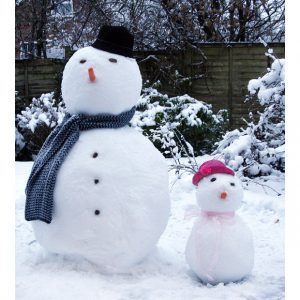 While snowmen are prominent modern symbols of Christmas, they do seem to lack traditional theological significance. I, however, see a great opportunity in them.
While snowmen are prominent modern symbols of Christmas, they do seem to lack traditional theological significance. I, however, see a great opportunity in them.
Theological Symbolism
Snowmen, like snow and winter, can remind us of the cold dead spiritual state of the natural man. In addition, they can symbolize those who have been made pure—white as snow—by the blood of Christ.
Snowmen can also symbolize the life Christ gives to the dead. Just as snowmen, in popular stories, come alive, so we, once spiritually dead, have been made alive in Christ.
John 5:24 “Very truly I tell you, whoever hears my word and believes him who sent me has eternal life and will not be judged but has crossed over from death to life.
Use snowmen to explain our positional purity in Christ—those of us who have placed our hope in him.
1John 3:3 And everyone who has this hope in Him purifies himself, just as He is pure.
Cold Climate Animals
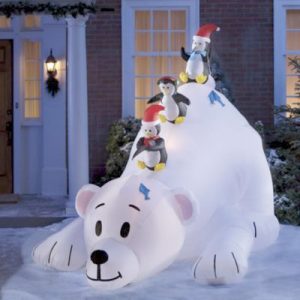 With snow being such a prominent Christmas symbol, it’s no surprise cold climate animals have been added to the mix. Reindeer, polar bears and penguins dominate the seasonal landscape. Narwals have been gaining popularity, interestingly. Arctic foxes and huskies have also become common fixtures. But, like snowmen, these lack theological significance—at least traditionally. That doesn’t mean, however, we can’t give them significance. Consider the following:
With snow being such a prominent Christmas symbol, it’s no surprise cold climate animals have been added to the mix. Reindeer, polar bears and penguins dominate the seasonal landscape. Narwals have been gaining popularity, interestingly. Arctic foxes and huskies have also become common fixtures. But, like snowmen, these lack theological significance—at least traditionally. That doesn’t mean, however, we can’t give them significance. Consider the following:
Theological Symbolism
Cold climate animals, like Winter itself, can remind us of the spiritually cold world Christ entered. They also can teach about the merciful provisions of our Creator, who equipped them to survive in harsh climates. Bears and penguins are great examples. (See: Bears across the world … Bears are some of God’s most amazing creatures!, also: Penguins—Perplexing and Proficient!)
Likewise, God gives us his Holy Spirit who equips us to persevere in a spiritually cold/fallen world. He has equipped us to bear the corruption of our environment. He “…will not allow you to be tempted beyond what you are able…” (1Cor. 10:13). God’s grace abounds, even in a fallen world.
CHRISTMAS TREES
 Christmas trees are evergreen trees (remaining green all year long), reminding us of the everlasting life we have in Christ.
Christmas trees are evergreen trees (remaining green all year long), reminding us of the everlasting life we have in Christ.
The star at the top of the tree can represent the hovering Eastern Star that announced Christ’s arrival to the Magi, or the angel who announced his birth to the shepherds. The Christmas tree can also represent Jesus, himself, while the lights and ornaments on it can represent his followers.
Centuries ago, Christmas ornaments were actual fruits that were brought in and hung on evergreen trees. They’ve since been replaced by synthetic ornaments, but carry the same meaning. Christmas trees, therefore, represent Christ, who established his Church and bore much fruit.
1Cor. 15:20 But now Christ is risen from the dead, and has become the firstfruits of those who have fallen asleep……. 23 But each one in his own order: Christ the firstfruits, afterward those who are Christ’s at His coming.
History
In early German traditions, the Christmas Tree represented the Tree of Life in the Garden of Eden. They were known as Paradise Trees. Followers of Jesus will see this tree, once again, in the New Jerusalem (Rev. 22:2, 14). Jesus specifically told us we will eat from this tree, again.
Rev. 2:7 Whoever has ears, let them hear what the Spirit says to the churches. To the one who is victorious, I will give the right to eat from the tree of life, which is in the paradise of God.
Teach your kids about the rich symbolism of the Christmas tree. It is the Gospel!
Santa Claus
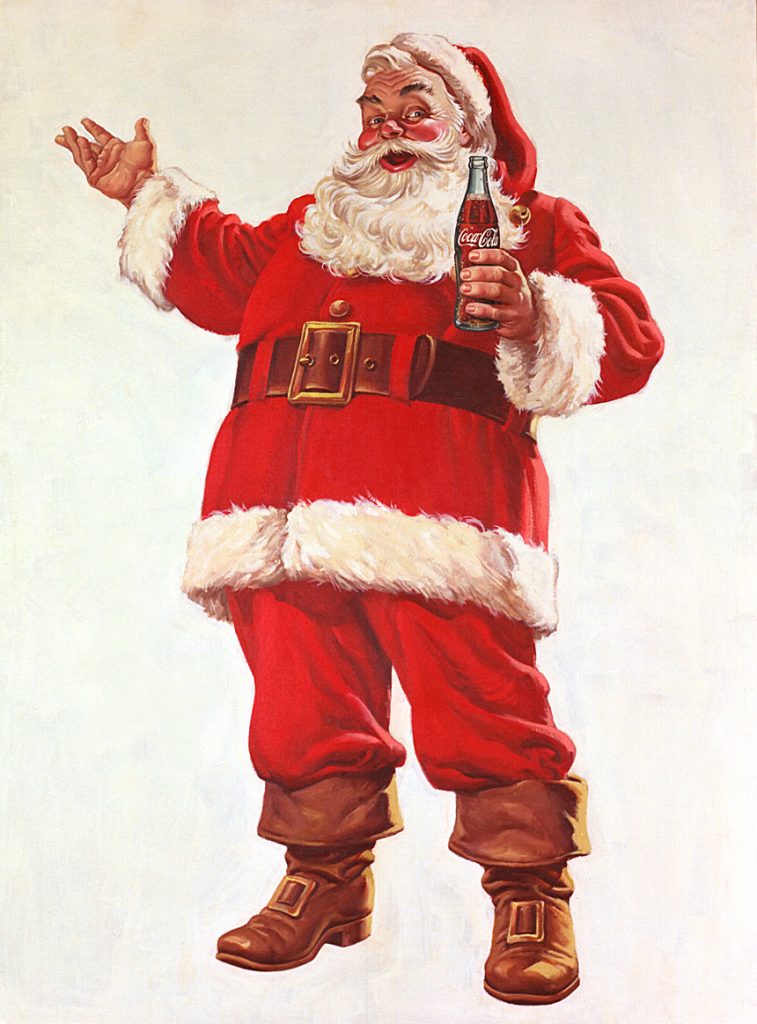 Santa Claus!? Oh, no, you did not just go there!?
Santa Claus!? Oh, no, you did not just go there!?
Yeah, I guess I did. Many see a stumbling block in Santa. I see an opportunity.
Nicholas of Myra
Nicholas of Myra is the historical figure behind the Santa Claus symbol. He was a famous (or should I say, legendary) Christian, known for his kindness and charity.
The real Santa (per legend) was a devout follower of Christ. Many believe he was present at the Council of Nicaea where he affirmed the deity of Christ and other essential doctrines. Legend has it, he was quite the zealot—even manhandling heretics and running them out of town (see: Bishop Nicholas Loses His Cool). He was more famous, however, for his kindness and charity, especially toward the poor.
Using the Santa Symbol
There will always be debate regarding the precise historicity of Nicholas and his deeds, but don’t get caught up in this. Nicholas serves as a wonderful symbol to teach your kids about the transforming power of the Gospel. The kindness and charity he exhibited were not natural, just as they are not natural to any of us. They were fruits of the Spirit who indwelled him.
Gal. 5:22 But the fruit of the Spirit is love, joy, peace, longsuffering, kindness, goodness, faithfulness, 23 gentleness, self-control. Against such there is no law.
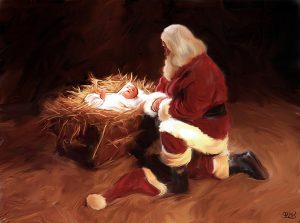 Let your kids know Santa is a worshiper of Christ. If you’re concerned he’s somehow replacing Christ or God, make the distinction clear. If you tell your kids Santa is not God, but a mere worshiper, they’ll believe you.
Let your kids know Santa is a worshiper of Christ. If you’re concerned he’s somehow replacing Christ or God, make the distinction clear. If you tell your kids Santa is not God, but a mere worshiper, they’ll believe you.
Once your kids grow older and debunk the North Pole version of Santa, introduce them to the historical Nicholas. Keep the Santa symbol alive. Let them know he was a redeemed sinner, transformed by the Holy Spirit. We who are in Christ can and will do the deeds of Nicholas, and beyond.
Phil. 2:13 for it is God who works in you both to will and to do for His good pleasure.
Research Nicholas
I recommend reading up on Nicholas of Myra, and sharing some of his stories. The articles below provide a good introduction.
Saint Nicholas of Myra, Bishop and Wonder-Worker
The Life and the Legend of the Saint Who Became Santa Claus
Who Was St. Nicholas?
Biblical Archaeology Society
Also read up on the transformation from Nicholas of Myra to the modern Santa Claus.
On the lighter side, check out Kirk Cameron’s Saving Christmas. Find it streaming this next Christmas season, or consider buying the DVD. It’s hilarious and you’ll find the segment on Nicholas a blessing—just as Kirk’s cynical brother-in-law did.
Christmas Stockings
 The tradition of Christmas stockings is tied to the legend of Nicholas. It comes from a particular story of him helping a poor man with dowries for his daughters. Wanting to help in secret, Nicholas delivered a bag of gold coins at night when the man and his daughters were sleeping. According to accounts, he reached through an open window, and placed the bag in a stocking hanging by the fireplace. He did this again on two other occasions covering all three daughters. You can read a detailed version of the story here: Legend of the Christmas Stocking.
The tradition of Christmas stockings is tied to the legend of Nicholas. It comes from a particular story of him helping a poor man with dowries for his daughters. Wanting to help in secret, Nicholas delivered a bag of gold coins at night when the man and his daughters were sleeping. According to accounts, he reached through an open window, and placed the bag in a stocking hanging by the fireplace. He did this again on two other occasions covering all three daughters. You can read a detailed version of the story here: Legend of the Christmas Stocking.
For us, filling Christmas stockings is a symbol of charity enabled by our changed hearts. It is a symbol of the work of the Holy Spirit.
Eph. 2:10 For we are His workmanship, created in Christ Jesus for good works, which God prepared beforehand that we should walk in them.
Christmas Gifts
Gifts are the main focus of Christmas for most kids, so don’t neglect their symbolism. The Christmas tradition of gift giving is largely influenced by the legends of Nicholas (the gift-giver of Myra). All Christians should be charitable gift-givers.
Our main focus, however, is Christ. He is the pearl of great price—the greatest gift of all. He is our gift from the Father (John 3:16). And he, himself, offers us the free gift of eternal life.
Rom. 6:23 For the wages of sin is death, but the gift of God is eternal life in Christ Jesus our Lord.
Jesus, also, gives us the gift of the Spirit, who empowers us to live the Christian life and abound in charity and good works.
2Cor. 9:15 Thanks be to God for His indescribable gift!
Gifts should point us also to the God the Father who is the ultimate gift-giver.
James 1:17 Every good and perfect gift is from above, coming down from the Father of the heavenly lights, who does not change like shifting shadows.
We’ll discuss gifts further in the Christmas Traditions section.
Christmas Folklore
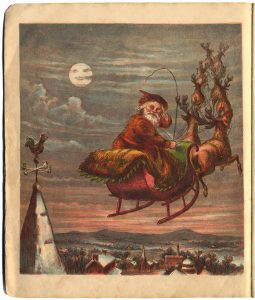 Much of the Christmas folklore we have today comes directly from the minds of poet Clement Clarke Moore and artist Thomas Nast. Moore’s, Twas the Night Before Christmas (originally called A Visit from St. Nicholas – 1822), along with Nast’s illustrations created the modern Santa story we all grew up with.
Much of the Christmas folklore we have today comes directly from the minds of poet Clement Clarke Moore and artist Thomas Nast. Moore’s, Twas the Night Before Christmas (originally called A Visit from St. Nicholas – 1822), along with Nast’s illustrations created the modern Santa story we all grew up with.
Christians have mixed feelings about what to do with this folklore. I, myself, see an opportunity.
The North Pole
Santa’s North Pole home was invented by artist Thomas Nast. It is not in the Night Before Christmas poem, but Nast made the connection later in an illustration called “Santa Clausville, N.P.” (short for North Pole). It seemed reasonable that if Santa was always dressed in winter clothes and hung with reindeer, the North Pole would make for an ideal abode. See: How the North Pole became part of Santa’s story
Being this symbol is here to stay, I suggest letting it represent heaven. Once your kids debunk the fictional story, let them know the real Nicholas is far more North than they realize. He has passed from death to life and is now in paradise with Christ.
Luke 23:43 And Jesus said to him, “Assuredly, I say to you, today you will be with Me in Paradise.”
This is the fate of everyone in Christ.
Immortality
The modern Santa is magical and immortal. This could be used to symbolize the glorified state Christians will attain at the end of the age.
Phil. 3:20 For our citizenship is in heaven, from which we also eagerly wait for the Savior, the Lord Jesus Christ, 21 who will transform our lowly body that it may be conformed to His glorious body, according to the working by which He is able even to subdue all things to Himself.
Once your kids debunk the magical attributes of Santa, turn them, too, into symbols. Use them to explain the new bodies all Christians will receive. We don’t know what they’ll be like (1John 3:2), but we know they will exceed by far anything a poet or artist could come up with.
Rudolph
Rudolph the Red Nosed Reindeer has indeed gone down in history. Kids love this story. I know I did.
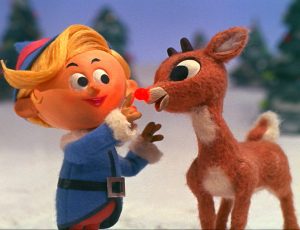 The film, essentially, is about misfits and outcasts realizing their unique talents and using them for good. Rudolph came to realize his luminous nose was the perfect remedy for a storm that almost cancelled Christmas. Apparently, Santa, despite all his magical technology, did not have a viable flashlight option to guide his sleigh. Plot holes aside, the Robert Lewis May story was a huge hit, and captivated the nation in booklets, movie adaptations and songs. Rudolph has become a true Christmas icon.
The film, essentially, is about misfits and outcasts realizing their unique talents and using them for good. Rudolph came to realize his luminous nose was the perfect remedy for a storm that almost cancelled Christmas. Apparently, Santa, despite all his magical technology, did not have a viable flashlight option to guide his sleigh. Plot holes aside, the Robert Lewis May story was a huge hit, and captivated the nation in booklets, movie adaptations and songs. Rudolph has become a true Christmas icon.
I, therefore, recommend giving this magical reindeer some usable theological symbolism. Rudolph used to hide his light, before finally allowing it to shine and accomplish great things. How much more should we, having a much greater light—the Gospel?
Luke 8:16 “No one, when he has lit a lamp, covers it with a vessel or puts it under a bed, but sets it on a lampstand, that those who enter may see the light.
Rudolph’s light saved Christmas. Ours, the light of the Gospel, saves souls.
Candy Canes
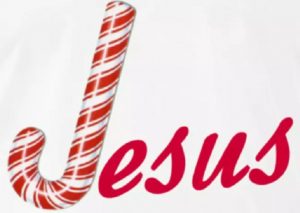 Candy canes are all over the place on Christmas. They are shaped like a shepherd’s cane to remind us of our good shepherd, Jesus.
Candy canes are all over the place on Christmas. They are shaped like a shepherd’s cane to remind us of our good shepherd, Jesus.
John 10:11 “I am the good shepherd. The good shepherd gives His life for the sheep.
When turned upside down, they becomes the letter J which stands for Jesus.
Candy canes are rocklike, reminding us of the the rock of our salvation (Psa. 62:6). They are striped to remind us of the stripes (wounds) Jesus underwent to heal us (Is. 53:5, 1Pet. 2:24)—red stripes representing his blood, white stripes, the purity it brings (I John 1:7). The peppermint flavor of candy canes represents biblical spices associated with sacrifice and embalming (like hyssop and those brought by the Magi). The brittleness of candy canes represents the fragile, breakable, human body Christ took on, which was broken for us (I Cor. 11:24). And the gifting of candy canes, represents the gift of Christ that is offered to all.
The story of the candy cane is a great way to share the Gospel with your kids and anyone else willing to listen. For more information, see: Teach About Jesus with The Legend Of The Candy Cane.
Wreaths
 Wreaths, like Christmas trees, are made from evergreens which represent everlasting life. Their circular design symbolizes Christ as an eternal being, with no beginning or end.
Wreaths, like Christmas trees, are made from evergreens which represent everlasting life. Their circular design symbolizes Christ as an eternal being, with no beginning or end.
Rev. 22:12 “Look, I am coming soon! My reward is with me, and I will give to each person according to what they have done. 13 I am the Alpha and the Omega, the First and the Last, the Beginning and the End.
Some wreaths are made from thorny plants which can represent the suffering Jesus endured, and the crown of thorns he wore. Explain this prominent symbol to your kids.
Holly
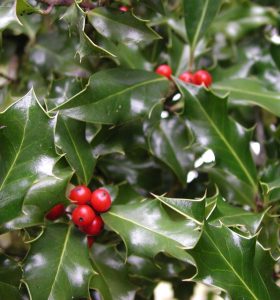 Boughs of holly are also common Christmas decorations. A bough (pronounced bow) is a branch. Holly boughs, being evergreen, also represent everlasting life. Their berries represent Christ’s blood and their thorns, his suffering.
Boughs of holly are also common Christmas decorations. A bough (pronounced bow) is a branch. Holly boughs, being evergreen, also represent everlasting life. Their berries represent Christ’s blood and their thorns, his suffering.
They can also symbolize branches of the Vine—the true Vine, Jesus Christ. True Christians remain in the Vine forever.
John 15:5 “I am the vine; you are the branches. If you remain in me and I in you, you will bear much fruit; apart from me you can do nothing.
Poinsettias
 Poinsettias are amazing plants with brilliant green and red leaves. They scream Christmas.
Poinsettias are amazing plants with brilliant green and red leaves. They scream Christmas.
According to folklore, they were once all green until the top leaves were miraculously turned red. This happened when two young poor kids gave them to a Church as a Christmas gift. You can read a detailed version of the story here: The Poinsettia – Christmas Flower.
For us, it’s all about the colors. They remind us of the blood of Christ (red) and the life it brings (green).
Gingerbread
Gingerbread, traditionally, does not have strong theological symbolism (as far as I’ve researched). It has, however, become a favorite Christmastime treat. You can read about its history here: Christmas Tradition of Gingerbread.
Nonetheless, we allow Gingerbread to remind us of Jesus—the bread of God.
John 6:33 For the bread of God is the bread that comes down from heaven and gives life to the world.”
 Jesus referred to himself as the bread of life.
Jesus referred to himself as the bread of life.
John 6:35 Then Jesus declared, “I am the bread of life. Whoever comes to me will never go hungry, and whoever believes in me will never be thirsty.
Gingerbread men and houses, therefore can symbolize people and households who follow Christ. Their multiple shapes and sizes can represent followers from every tribe, tongue, and color. Don’t miss the wonderful teaching opportunity these tasty treats provide.
Using Christmas Traditions
I also find great opportunity in the many traditions of Christmas. No other holiday boasts more cherished events and activities. Don’t let them go to waste. They too can help explain the Gospel if you let them.
Gift Opening
The anticipation of Christmas day can be overwhelming for kids. They look at those gifts under the tree day after day, as the calendar winds down. While not particularly fun, this tradition of waiting can be theologically instructive.
Men had been waiting for the coming Seed since God first prophesied about him in the Garden of Eden (Gen. 3:15). Just as wrapped gifts offer subtle clues about their contents, so messianic prophecies offered clues about who the Messiah would be, and what he would do.
When your kids talk about the difficulty of the wait, I recommend reading to them the account of Simeon, who knew messianic prophecy and waited a life-time to see his Messiah.
Luke 2:25 And behold, there was a man in Jerusalem whose name was Simeon, and this man was just and devout, waiting for the Consolation of Israel, and the Holy Spirit was upon him. 26 And it had been revealed to him by the Holy Spirit that he would not see death before he had seen the Lord’s Christ. 27 So he came by the Spirit into the temple. And when the parents brought in the Child Jesus, to do for Him according to the custom of the law, 28 he took Him up in his arms and blessed God and said:
29 “Lord, now You are letting Your servant depart in peace, According to Your word; 30 For my eyes have seen Your salvation 31 Which You have prepared before the face of all peoples, 32 A light to bring revelation to the Gentiles, And the glory of Your people Israel.”
We, also, will wait a life-time to see our Lord face to face. Not easy, but it will be well worth the wait.
Christmas Music
There are a couple of secular radio stations in my area who switch to Christmas music 24/7 in November and December. During this time, they play the classics: Silent Night, Joy to the World, Carol of the Bells, Little Drummer Boy, etc. The secular hits are blessings as well, as they repeat that politically incorrect word—Christmas!
I marvel how this happens in an increasingly antagonistic and politically correct society. It’s one of many reasons I’m thankful Christmas is mainstream, and not just a religious holiday. What other time of year do we hear the name of Christ proclaimed and exalted in public venues?
I recommend creating your own Christmas music list to meditate on during the season. Here are some of my favorites.
- “Do You Hear” Whitney Houston
- “Little Drummer Boy” Bob Seger & The Silver Bullet Band
- “Please Come Home For Christmas” Eagles
- “O Holy Night” Céline Dion
- “White Christmas” The Drifters
- “Joy to the World” Train
- “Hark! The Herald Angels Sing” Carrie Underwood
- “I’ll Be Home for Christmas” Tony Bennett
- “Deck the Halls” Mannheim Steamroller
- “Carol of the Bells” Mannheim Steamroller
- “Rudolph the Red-Nosed Reindeer” Ray Charles
- “That Christmasy Feeling” Johnny Cash
- “The First Noel” Rascal Flatts
- “Silent Night” Martina McBride
- “Blue Christmas” Elvis Presley & Martina McBride
- “Jingle Bells” Frank Sinatra
- “Drummer Boy” Idina Menzel, Jennifer Nettles
- “Have Yourself a Merry Little Christmas” Dan + Shay
- “A Holly Jolly Christmas” Lady Antebellum
- “What Child Is This?” Carrie Underwood
- “Let It Be Christmas” Alan Jackson
- “God Rest Ye Merry Gentlemen” Rascal Flatts
Concerts, Shows and Events
Christmas concerts and events are available in abundance during Christmas season. Many churches put together high-end productions with talented choirs and orchestras. Others put on Nativity plays and winter festivals. One pastor friend of mine puts on a “Town of Bethlehem” simulation that’s quite the hit in his town.
Tickets for these events are normally free, as they are opportunities to share the Gospel. Use these events to stimulate conversations and sharing opportunities.
Christmas Light Drive
In our town, there are several brilliantly decorated houses to visit in December. One cul-de-sac in particular, has become legendary, with all the residents participating in a big way. People drive and walk its sidewalks, every December, turning it into a month-long block party.
I can’t think of a better time to talk to your family about the theological significance of lights and other symbols.
Christmas Treat Talk
Christmas treat talks are a personal tradition I’ve come up with. In short, it’s a time to eat traditional Christmas treats with my kids and talk about Christmas symbols. We usually have it on Christmas Eve or the day before.
In these, we briefly review points from our last candy talk on Halloween—the Fall, Curse, and promised Seed. Everything goes back to Genesis! Before going forward, I need to remind them there was a real nightmare before Christmas—one Tim Burton and Hollywood know nothing of. (See the previous article in this series.)
Then, while snacking on gingerbread, peppermint bark and other seasonal favorites, we talk about the long awaited arrival of Christ. Allow your kids to drive the discussion. Let them pick the symbols they want to discuss and listen to their questions carefully. And don’t feel the need to cover every symbol. I recommend letting them choose a few, and change it up every year. The more your kids set the tempo, the more they’ll enjoy and retain the information.
Christmas Dinner
Second only to Thanksgiving, Christmas dinner is a feast to remember. Like Thanksgiving, it normally features a turkey or ham, and numerous side-dishes and desserts.
Feasting, in and of itself, is signifiant for Christians. Jesus will dine, one day, with those who open their hearts to him.
Rev. 3:20 Behold, I stand at the door and knock. If anyone hears My voice and opens the door, I will come in to him and dine with him, and he with Me.
This, in part, likely refers to the marriage supper of the Lamb.
Rev. 19:9 Then he said to me, “Write: ‘Blessed are those who are called to the marriage supper of the Lamb!’ ” And he said to me, “These are the true sayings of God.”
For more on this see: What is the marriage supper of the Lamb?
Think of this future feast during Christmas dinner. Make it as good as humanly possible, but, let your family know a better feast is coming.
New Years
For us, Christmas season spans from Black Friday (the day after Thanksgiving), to New Years Day. Most seem to agree with this, keeping their decorations up and lights on until New Years Day or later. The two holidays are often mentioned in tandem in songs and greetings—Merry Christmas and Happy New year. This makes sense, considering their proximity.
My daughter asked me the other day if New Years could also be used symbolically, in any way, to point us to Christ. What a great question! The answer is absolutely, in fact, it wouldn’t really be that symbolic. Our modern calendar is already based on the birth of Christ. All history is now BC, before Christ, or AD anno Domini (in the year of the Lord), all history during the earthly life of Christ and afterward.
Every year, Christmas ushers in a new year, which can remind us of this new era Jesus ushered in. The year we celebrate tells us approximately how long ago Christ was born. I say approximately, as there is no consensus on the precise date. The BC/AD system was not implemented until the 8th century and the implementors likely were off a few years. For more on this see: What is the meaning of BC and AD (B.C. and A.D.)?
How fitting, though. Jesus is the primary reference point of all history, just as he should be. He is the creator of history. He impacted history and our calendar like no one else could. Remind your kids of this magnificent truth every New Years Eve as the timer counts down.
Concerns and Objections
Commercialism & Materialism
Commercialism has ruined Christmas!
There are many things wrong with this objection. First, there is nothing, in and of itself, wrong with commercialism or capitalism. Neither gift giving nor receiving are condemned in Scripture. Investing in gifts and decorations is a good thing, especially if it honors Jesus. Think of the poor woman the disciples rebuked when she anointed Christ with a costly bottle of perfume. Jesus rebuked them and praised her gift (Matt. 26:7-13).
Instead, we should be thankful for a free capitalistic society which allows us to invest in this great holiday. Would we rather be restricted under communism? For a more in-depth look at this topic, see: What does the Bible say about capitalism?
Second, commercialism creates more opportunity for the Gospel, not less. It costs money to decorate towns which, in turn, promotes the season. Americans love Christmas, and many churches take full advantage (as they should). They offer productions, musicals and snow festivals which anyone can attend. These are great opportunities to expose people to the Gospel.
Third, Christmas commercialism saves many businesses, and through this, blesses many families. Black Friday is specifically known to move companies from red (debt) to black (profit) for the year. How is this a bad thing? Do we really want to end this?
The commercialism/materialism charge is a non-starter. Don’t let it steal your joy.
Secularism
Christmas has become secular. The message of Jesus’ birth is lost!
Hopefully the information above has mollified this concern. The message of the Nativity is everywhere on Christmas, for those willing to see it.
It is certainly true that many Americans choose not to focus on Jesus during Christmas. They don’t look at Christmas symbols the same way I do, and that is their choice. I see no reason to worry about this so long as I’m free to celebrate and decorate how I choose. I definitely don’t want my society compelling religiosity. Instead, I enjoy the freedom which allows me to look and pray for opportunities to share what Christmas means to me.
Paganism
But Christmas is pagan! It’s a revived pagan festival!
Christmas, perhaps more than any other holiday, is inundated with charges of paganism. The answer to these charges is the liberty Paul outlined for us in Romans 14. We Christians need not worry what ancient pagans did, and what symbols they used. If you use them to glorify God, it is acceptable worship.
That said, most of the charges against Christmas and its symbols are erroneous. They are riddled with fallacious history and bad logic. For an in-depth study, I recommend this small online book by JP Holding: Christmas is Pagan and Other Myths. To my knowledge, it’s only available in a kindle edition. Whether you’re struggling with doubts or fielding objections, you’ll find this book a blessing.
In short, there is very little evidence Christmas evolved out of pagan traditions. There is a rumor that Church officials chose December 25th to christianize a formerly pagan tradition. It’s possible, I suppose, but even if true, this would not be a problem, so long as we’re not engaging in actual paganism.
That said, there is little evidence supporting this rumor. Ancient pagan holidays were celebrated all year long. Had a different day been chosen, critics would have found a different pagan connection. The mere proximity of an ancient holiday is not proof it influenced a modern one.
Unbiblical
Christmas is not a biblical holiday. There are many holidays in the Bible, but nothing about celebrating the Nativity.
This is true, in fact no holidays are commanded throughout the entire New Testament. Paul, instead, gives us liberty to set aside sacred days in accordance with our conscience.
Rom. 14:5 One person esteems one day above another; another esteems every day alike. Let each be fully convinced in his own mind. 6 He who observes the day, observes it to the Lord; and he who does not observe the day, to the Lord he does not observe it.
That should be crystal clear to all. Celebrating Christmas is not compelled, but it is also not prohibited.
Romans 14 was written on the heels of Romans 13 which is about living in Gentile nations under Gentile governments. It’s not surprising, therefore, that Paul then addressed sacred days and holidays, as they exist in every nation. Christians would have wondered what to do with them, and Paul tells us very clearly we have liberty in accordance with our conscience.
This was not the case, by the way, for Israel which was a stand alone nation. God established Israel with laws and traditions, including holidays. There are 7 of them. He did not, however, do this for the Church, apart from communion on the first day of the week. The rest was left up to us.
Celebrating the Nativity, annually, is perfectly acceptable to God, so long as it’s done with a clear conscience.
Rom. 14:18 For he who serves Christ in these things is acceptable to God and approved by men.
It does not matter if a celebration is outlined or commanded in the Bible. You are free to observe or ignore any sacred day. If you enjoy Christmas, celebrate it to the fullest. Conversely, if it violates your conscience in any way, don’t celebrate it. “….for whatever is not from faith is sin…” (Rom. 14:23).
Final Thought
I’ve always told my kids, if you want Christmas to remain magical, you have to give it theological significance. If it is reduced to confusing decorations and year-end gifts, the magic will fade. It’ll become mundane, even burdensome.
If, on the other hand, it points you to Jesus and the Gospel, the magic will remain and multiply. I hope this article contributes to that end.
Next, we’ll take a closer look at Easter and its confusing symbols.
Previous Article
Explaining the Gospel through Holidays – Part 1: Halloween
The Fall and the Promise of Christ
Next Articles
Explaining the Gospel through Holidays – Part 3: Easter
The Cross of Christ
Explaining the Gospel through Holidays – Part 4: Independence Day
The Return of Christ


Leave a Comment
You must be logged in to post a comment.